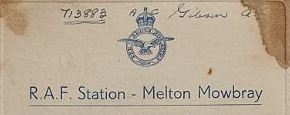As we celebrate the 75th Anniversary of WW2 ending in 1945 and the celebrations begin with #VEDay75, the 75th Anniversary of Victory in Europe (more commonly known as VE Day) on the 8th May, I take a look at the story of RAF Melton Mowbray and its role during WW2.
As you go from Melton Mowbray to Great Dalby along the B6047 road, the airfield is on your right and the road was once part of the perimeter track. The airfield was built in the early 1940s as part of the Royal Air Force expansion during the Second world War.
The original plan for RAF Melton Mowbray was for it to become a Maintenance Command Station, but by the time it opened on 1st August 1943 control had been given to No 44 Group, Transport Command.

It was designed, with the intention of it eventually becoming an operational bomber station, as it was built with two bulk fuel installations. This was the usual provision for fuel installations on operational bomber stations. The two tank units, each holding the maximum 72,000 gallons was policy for operational units which had to store enough fuel for six weeks of intensive operations.
One of the first serviceman to arrive at the new unit was Flt Lt J Milton (Equip) who performed the duties of the Senior Equipment Officer, and it was his job to arrange for the supply of stores. Sqn Ldr R J Sanceau (G.D.) was posted in and became the first Commanding Officer of the new unit. Once the NAAFI was built and the camp had been certified fit for use by a Senior Medical Officer the Permanent Staff would be posted in.
During August 1943, the units strength of personnel increased to 12 Officers and 123 Airmen and Airwomen who were employed on routine work, preparing the station for the arrival of the aircraft.
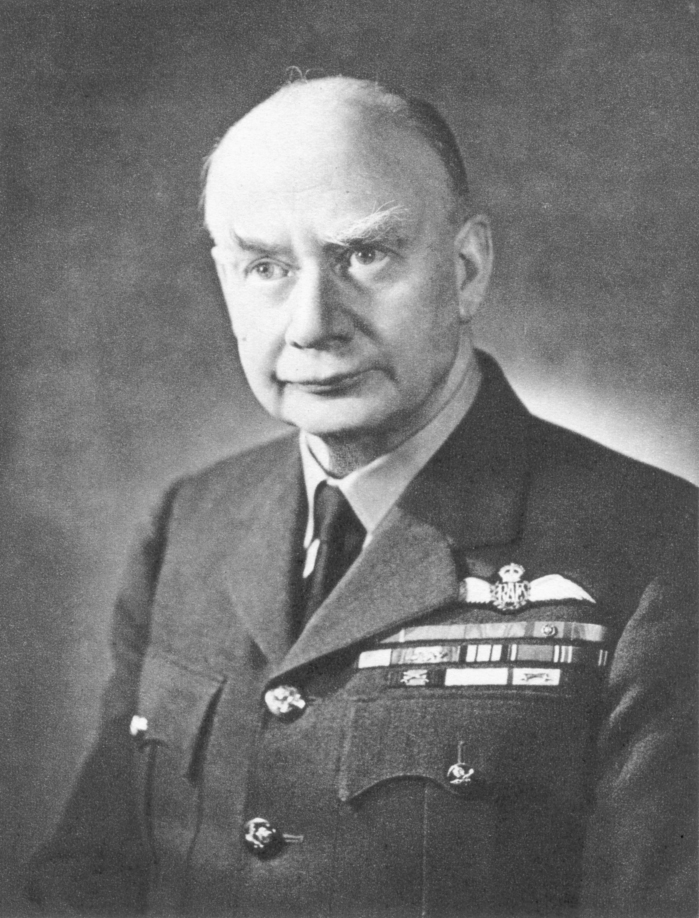
The newly opened station was inspected on 6th August by Air Chief Marshall Sir Frederick Bowhill GBE, KCB, CMG, DSO. Back in 1941 when he was AOC in C Coastal Command, he used his knowledge of the sea and plotted the Bismarck’s likely course. This resulted in a Catalina being sent to search the area, successfully finding it resulting in the Bismarck sinking on the 27th May 1941.
The newly opened airfield was again inspected on 1st September, this time by The Air Officer Commanding No 44 Group, Air Commodore Kingston-McCloughly CBE, DSO & DFC.
The first unit to arrive was No 4 Overseas Aircraft Preparation Unit (OAPU) which handled various types of aircraft including Spitfires, Mosquitoes, Corsairs, Vengeances, Hellcats & Halifaxes.

Wing Commander B A Oakley arrived at Melton on September 4th and took over command of No 4 OAPU and the station from Sqn Ldr R J Sanceau.
John McCafferty was an airframe fitter who was posted to No 4 OAPU B Flight as an LAC after returning to the UK from a tour in West Africa. He arrived at Melton during November 1943 and he remembers that all new arrivals spent their first 7 days on duty crash crew at the watch tower, or to use its modern name the control tower, before proceeding to their respective flights.
As the title of the unit suggests, No 4 OAPU was responsible for prepping aircraft and dispatching them to overseas units. A large number of modifications were required to convert a Spitfire for tropical operations. These included the deletion of two lower engine cowling panels, the standard oil tank had to be replaced with one of a larger capacity, the air intake fairings were replaced, a tropical air filter was fitted and fixed fittings were installed to accomodate the additional fuel tanks known as either ‘overload’ tanks or ‘slipper’ tanks.
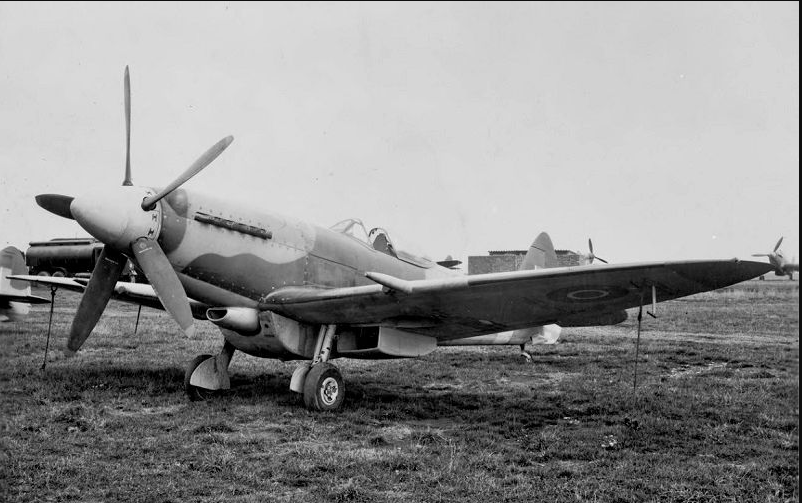
Slipper tanks came in various sizes, ranging from 30 gallons up to 170 gallons, and it was the 170 gallon tank that was fitted to Spitfires for ferry flights. The advantage of the 170 gallon tank was obvious, but it did have its disadvantages. The shear size of the tank, which was fitted to the underside of the fuselage behind the air intake caused an increase in drag, which subsequently made the aircraft very difficult to fly unless flying straight and level. Another problem was that the guns and ammunition had to be removed due to the extra weight that the aircraft was carrying, This subsequently meant that the ferry aircraft were prone to attack from enemy aircraft after the fighter escorts had left them at the Bay of Biscay. The guns and ammunition would be refitted when the aircraft reached its destination.
After carrying out the modifications to the aircraft as part of the preparation for overseas tours, John remembers the codeword ‘SNAKE’ being painted on the fuselage of the aircraft. Quite often, as the aircraft stopped off on route to refuel, resident squadrons that were short of aircraft acquired the newly arrived and modified aircraft for use by themselves and the aircraft never reached its final destination. The painting of the word ‘SNAKE’ was supposedly a deterrent to ensure that the aircraft arrived at its destination in the Far East, although some aircraft were still diverted from their original destination.

John remembers working on numerous different types of aircraft such as: Spitfires, Grummen Martlets, Grummen Hellcats, B25 Mitchells, A20 Bostons, P51 Mustangs, Wellingtons, Lancasters, Stirlings and Liberators. Many of the aircraft were flown into Melton by female ATA pilots who were not familier with the type of aircraft they were flying. To get round this problem of unfamiliarity, the pilots had a pad of pilots notes strapped to their right leg, just above the knee, from which they worked out the starting procedures. John recalls watching many aircraft perform ‘hairy’ take-offs which was another problem caused by unfamiliarity.
One incident that John remembers was when a female ATA ferry pilot had just delivered a brand new Wellington bomber from the Vickers factory. After landing the pilot had reported to the groundcrew that the elevator controls were the heaviest she had known. After lots of investigation by the groundcrew and various test flights, the controls were still heavy. Eventually someone had the idea of removing the fabric from the elevator control surfaces which revealed the problem – a complete tool kit in a canvas tool bag had been left inside the elevator when it had been manufactured.
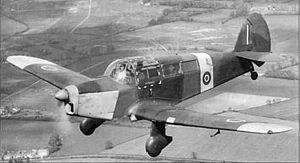
Another aircraft that John remembers stationed at Melton was a Percival Proctor MkIII serial number Z7252 and this was the Station Commanders aircraft.
Sunday 26th September was the annual Battle of Britain parade and a detachment of RAF and WAAF personnel took part in Meltons parade.
During October, various new units were formed at Melton. Sqn Ldr I R Blair (T.Eng) arrived on 1st October on attachment from No 1 OADU to form a maintenance wing on the station. On the 7th October, Flt Lt N H Kellitt (G.D.) reported from Long Kesh by air in connection with the movement of No 306FTU from Long Kesh to Melton. On the 9th October Flt Lt W M Smedley (T.Eng) accompanied by Flg Off F R Mason (G.D.) and Flg Off P H C Pinnock arrived from Finmere in connection with the movement of No 307FTU to Melton. The advance party from No 306FTU consisting of 3 Officers and 68 other ranks arrived at Melton on the 14th October, and the advance party of 12 Officers and 217 other ranks from 307 FTU arrived on the 15th.
The role of the FTU was providing the newly formed bomber crews with all the training they required prior to them being posted to operational squadrons. The training usually lasted about 8 days in total. The short but intensive course consisted of 4 days ground instructional and 4 days flying, after which the aircrew would proceed overseas.
Prior to travelling overseas the aircrew should be fully innoculated, vaccinated and fit for overseas service before arriving at Melton. Quite often the aircrew would arrive at Melton requiring Yellow Fever, Typhus and TABC innoculations and vaccinations. This subsequently meant a frantic rush for the medical staff to get the aircrew fully fit without hindering the short flying programme and most of all not to hold up the delivery of aircraft overseas.
Even worse than arriving at Melton without innoculations was when aircrew reported sick immediately upon arrival at Melton with complaints, some of which they had been nursing for months. Sometimes the complaint was serious enough to be admitted into hospital for investigation, this meant removing the crew from their training course and subsequently the flow of aircraft overseas was interrupted. For the ‘genuine’ cases that did require investigation, the RAF Hospital at Rauceby realised the rush nature of Meltons problem and co-operated as much as they could.
Ron Acton was an Engine fitter posted to Melton during 1943 purely by chance. Ron was posted from his current unit to the top of Scotland and on his way to get his posting details from the clerk he noticed that postings to RAF Melton Mowbray were being advertised on the blackboard. Ron spoke to his clerk about swapping his posting who replied that it would cost him ten bob. Ron paid him the money which was equivalent to about a weeks wages and was posted to Melton which pleased Ron as he came from Asfordby Hill, on the outskirts of Melton.
Initially the new camp was not a good unit to be based. Ron began to wonder what he had let himself in for, getting posted to Melton. The first thing that he remembers about arriving at RAF Melton Mowbray was being issued with a pair of Wellington boots. Everywhere was ankle deep in mud and sludge as the footpaths had not yet been built. The accomodation was not that brilliant, John recalls being billeted in Nissen huts with coke stoves to provide the heating, although there was not enough coke available to heat them. Proposals were made to the Medical Officer to have all the ventilators in the sleeping accomodation blocked up due to the excessive amount of draughts and dampness that they caused. This was vetoed by the Medical Officer for the reason that the huts are heated by slow combustion stoves burning coke which are known to give off poisonous gases, adequate ventilation must be maintained.
The airmen had outside ablutions and the accomodation was situated miles from the dining hall, sick quarters and work. Due to the large area that the sites were dispersed over, the bicycle was a common and popular mode of transport. It also proved to be a popular cause of accidents, people quite often requiring minor surgery, sometimes major after having accidents with bicycles.
The water supply to the station was severely rationed following a breakdown at the pumping station on the 29th October. The supply of water was fully restored by the 31st.
Although the country was at war, and there was lots of work to be done prepping the numerous different types of aircraft for overseas duties, Ron recalls there still being time to relax and play a game of football against the hanger doors.
A discussion group was formed on the station, and for its first meeting which was held during October, the chosen subject was ‘Post War Housing’. An entry in the Daily Operations Record Book for Melton states that ‘most of the W.A.A.F.s appeared to be keenly interested in this subject.

This month also saw strenuous efforts being made in connection with entertainment after ‘cease work’. An ENSA concert party and the Hurricane concert party made appearances and a recently organised Station Concert Party gave a show at the Corn Exchange in Melton.
Ron remembers working on numerous different types of aircraft such as Spitfires, Lancasters, Liberators, Flying Fortresses and lots of different American aircraft. The aircraft would get fitted out with extra fuel tanks and painted in the appropriate colour scheme for whichever theatre of war they would be operated in. Once ready, the aircraft took off from Melton for Redruth in Cornwall where they stopped and refuelled. After taking off from Redruth they were joined by the fighter escorts who would escort them as far as the Bay of Biscay. Apparently there were a lot of losses after the escorts departed.
At the end of November airmen started to arrive at the station on posting to the Maintenance Wing.
On New Years Eve a station Dance was held in the Sgts Mess and was open to all ranks.
On 13th January 1944 No 304 FTU arrived from Port Ellen operating Beaufighters, Beauforts, Bostons and Wellingtons. By the end of January the 3 FTU’s had amalgamated and were to be known as No 304 FTU under establishment WAR/AT/134.
Jimmy Learmonth was stationed at Melton during 1944/45. He arrived at Melton during the first week of 1944 as part of the advance party for No 304 FTU which was transferring from the Isle of Islay. The party was flown down in Bombay aircraft which were stationed at Doncaster Racecourse.

After an overnight stay at Doncaster they took off again in the Bombay’s and headed for Melton. Jimmy remembers arriving at Melton and not being able to see ‘a single blade of grass’ due to the large amount of aircraft such as Halifaxes, Lancasters, Mosquitoes, Beaufighters and numerous other types that were scattered across the airfield.
On 17th January 1944 No 1 Ferry Crew Pool was transferred to Melton from Lyneham in Wiltshire, but only stayed two months and then moved on again to Pershore.
During January 1944 personnel had to frequently work overtime due to the shortage of staff through sickness. Several much appreciated concerts took place throughout January and were held on the Communal Site.
In February 1944 the compliment of station personnel had grown to 1830 Officers, SNCOs and Airmen with 295 WAAF Officers and Airwomen and again concerts were held in the Gymnasium on the Communal Site at least once per week.
The airfield was closed on 27th February 1944 due to heavy snow falls. The depth of the snow on the main runway varied between 6 and 12 inches and it took until 15.00hrs on the 27th to clear the main runway. It was not until 16.00hrs the following day that the other runways were cleared of snow and the airfield became fully operational again.
The AOC No 44 Group Air Commodore G R Beamish, CBE visited the station on the 17th/18th March and according to the resume written by G/Capt C F H Grace, the Station Commander, the AOC congratulated No 4 OAPU on their work, although he was not satisfied with much else that he saw.
Whilst at Melton, Ron remembers one of the Physical Training Officers that was posted in, it was the boxing champion Len Harvey, who arrived at Melton on March 1st. Whilst stationed at Melton, Len consented to coach the boys from No 1279 (Melton Mowbray) Sqn Air Training Corps (A.T.C.) at boxing and these coaching sessions turned out to be popular with the boys.

The following report appeared in The Melton Times on 30th June 1944.
‘ATC Boxing Champions in the Making?
The first of the boxing lessons given by F/O Len Harvey took place on Wednesday when over 40 cadets attended. It is of course too soon to predict whether there are any potential champions in Melton!’
On 31st March 1944, three American aircraft diverted into Melton as the runways at their own units were still closed due to snow and Melton was the first unit to clear its runways. Melton was quite often used as a diversion airfield for the aircraft that normally operated from places like Leicester East and Wymeswold. If the aircraft couldn’t make it back to their own base they would divert into Melton as it was in a direct line with their unit.
The month of March was a notable one as far as aircraft dispatches were concerned, with a record number of 105 various aircraft being dispatched from No 4 OAPU and No 304 FTU.
German and Italian Prisoners of War used to work the land on local farms around Melton. Ron remembers one particular day when a German PoW escaped from the farm and he was found on the airfield, in the cockpit of an aircraft trying to start the engines and escape.
Personnel based at RAF Melton were invited by Lt/Col Sparling, Officer Commanding Army Remount Depot stationed in Melton to take part in horsemanship classes. No charge was made for these classes and those personnel with experience at horse riding were allowed to ride without supervision and the classes proved very popular with all ranks.
There was a reduced number of aircraft dispatched during April. This reduction was partly due to the record output during March and the fact that the commitments have temporarily eased off. In spite of this No 4 OAPU managed to dispatch 53 various aircraft, their highest figure since the formation of the unit.
Even though the airfield had been open for approximately ten months, there was still a lot of building work going on around the station. Work by McAlpine Ltd. started at the beginning of April with the filling of spaces between the spectacle hard-standings and the construction of new aprons outside No 1 & 3 hangars.
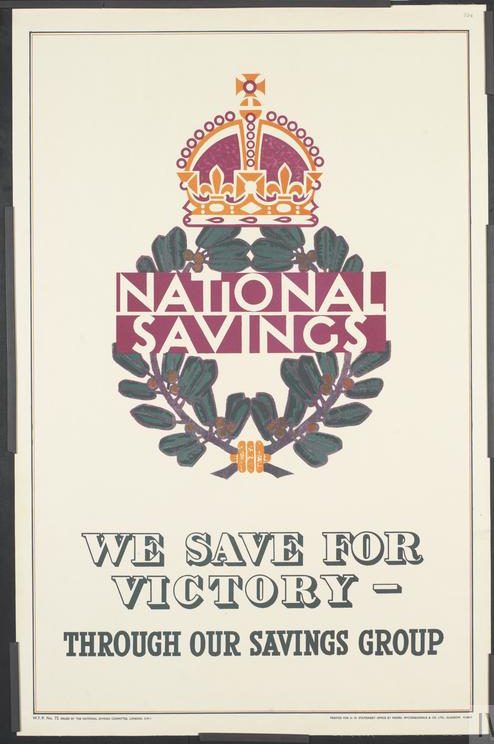
The beginning of April saw the formation of the stations National Savings Group which proved very successful with a total amount of £919/2/6d being saved, an average of 10/8d per person.
The Stations new theatre was completed during May and fully equipped with up to date equipment. The first show given by the Station Dramatic Society lasted for 3 successive nights and was an outstanding success.
Flt Lt Carter, who was the Catering Officer, was also kept busy during May reorganising the stations messing facilities and fitting a lot of new equipment which had been painstakingly sought out.
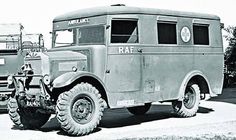
The month of May saw the arrival of Meltons first fully equipped crash ambulance. It was an Albion ambulance with a crane and hook apparatus on the roof for attachment to parachute harnesses.
It also contained a fireman’s axe and two pairs of asbestos gauntlets for fire rescue. Inside the ambulance was an oxygen apparatus contained in a specially constructed wooden container secured to the wall, comprising an oxygen bottle, mask and flowmeter etc.
A large number of the stations airmen underwent training in stretcher bearing and loading ambulances during May. The station was ‘gearing up’ for the reception, housing and disposal of casualties arriving at Melton by air. The ‘Operational Record Book’ quoted that casualties could be disposed of at the rate of 28 per load per one and half hours. Three ambulances and four lorries equipped with Flint stretcher gear were made available. Sign posts were being erected at all prominent positions around the camp.
May ‘44 was again a quiet month as far as aircraft dispatches were concerned, approximately 60 aircraft were dispatched. Full advantage was taken with the lull in aircraft work when a lot of ‘self help’ work was done with the cleaning up and improving the general appearance of the station.
June was another month where aircraft dispatches were at a low. A total of 26 aircraft, of which 10 were Stirlings were prepared and dispatched.
It was becoming quite a frequent occurrence for personnel, in particular WAAFs, to report sick with complaints of nerves, rundown, insomnia and anorexia usually accompanied with emotional outbursts. The main reason for these complaints was the lack of leave. The best possible cure for all these complaints would be leave, but if the SMO started recommending leave then there was a great possibility of an epidemic breaking out with the illnesses, however leave was granted on compassionate grounds. The main cause of the ‘leave sickness’ as it was called, was put down to the inequality that existed on all stations. Personnel who lived within a reasonable distance of the station usually managed to get home during their 24 hours off duty, whereas those personnel who lived several hundreds of miles away were not able to get home at all.
On the 26th June, WAAFs stationed at Melton started attending Melton Mowbray Senior Girls School for cookery lessons.
Another airman that was stationed at Melton was Jack Williamson. Jack was awarded the nickname ‘Snowy’ while at Melton as his hair was jet black. Jack remembers being asked to work late one night by his Chief as a Sqn of Fleet Air Arm Swordfishes came into Melton for an overnight stay.
Jack was a witness to the Wellington that crashed between Thorpe Arnold and Saxby Road on 13th August 1944. Jack remembers thinking ‘Whats he doing flying away from the airfield with one prop feathered?’ when it hit a haystack and burst into flames. Jack was one of the first people to arrive at the incident and managed to drag one of the crew members out of the flames, although to no avail as he was already dead from the fatal burns he had received.
As the RAF Ambulance and medics arrived at the scene, Jack said to one of them ‘look after this chap a minute’ and crept away from the scene as he didn’t want any publicity for his actions. After the accident, everybody was asking who was this brave airman was but nobody knew. A couple of days later back at camp, all the airmen were getting inspected as it was the CO’s parade and Jack was picked up as his uniform was all burnt from rescuing the crewman. From this they deduced that Jack must have been that airman whom they were searching for and he was subsequently awarded a citation for his heroism.
The dispatch of aircraft during August 1944 was reported as disappointing due to a problem with the Beaufighters. Apparently the rate of petrol consumption was too high to enable them to reach their destination in South Africa safely. A record number of aircraft were dispatched overseas during May 1944 when a total of 53 aircraft were transferred from Melton.
On 30th Oct 1944 a single Lancaster was secretly dispatched to Australia from Melton. G for George, an Avro Lancaster Mk.I serial number W4783 AR-G, operated by No. 460 Squadron Royal Australian Air Force. The aircraft flew 96 combat missions over occupied Europe with 460 Squadron, and is the second most prolific surviving Lancaster, behind R5868 S for Sugar which flew 137 sorties with No. 83 Squadron RAF, No. 463 Squadron RAAF and No. 467 Squadron RAAF.
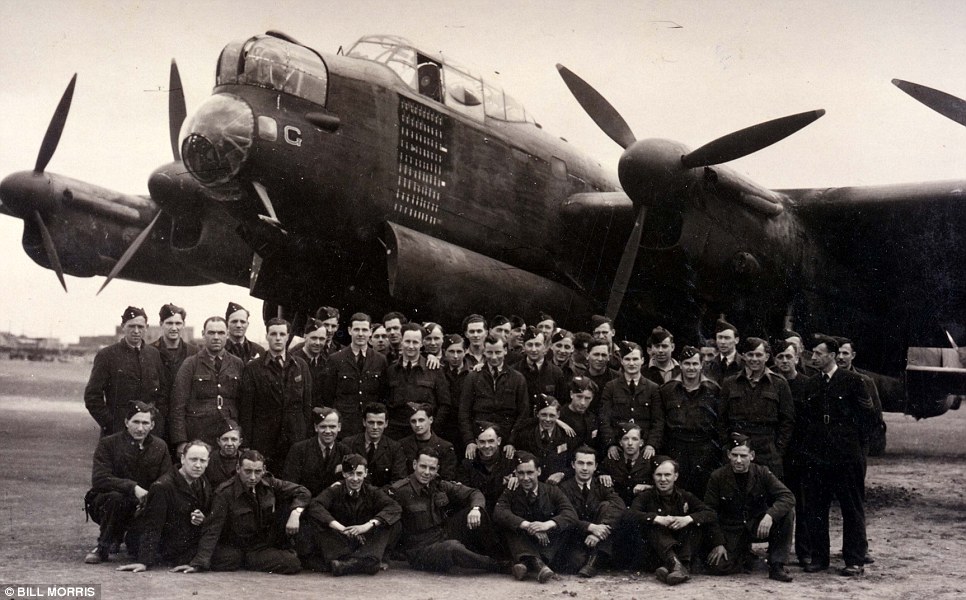
On the 16th October 44, RAF Melton received another special tasking via Air Movement Order (AMO) regarding two special commitments, No’s 1075 & 1076 which had been issued by HQ No 44 Group. This AMO required both No 4 OAPU and No 304 FTU to prepare and deliver two specially modified Avro Anson aircraft. One for the King of Egypt and the other for the Regent of Iran. Sqn Ldr Gallaway piloted Anson NK150 to Cairo for the King of Egypt and Flt Lt Smith piloted Anson NK151 to Iran for the Regent. The aircraft were eventually dispatched in December 44 and January 45.
Bill Johnston of Ewetree Farm remembers being invited to a birthday party of an Airman’s son who lived in Gt Dalby. After the party, the airman took his son and Bill up to the airfield and let them sit in an American Grumman Hellcat fighter.
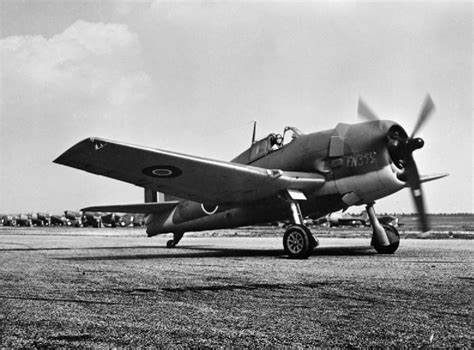
Bill recalls seeing lots of different types of aircraft such as Halifaxes, Bostons and Mosquitoes. The thing that he remembers most about the Mosquito is that they were white or silver in colour instead of camouflage. Another of Bills recollections is of the Airmen down in Gt Dalby village scrumping apples.
Jimmy Learmonth was a professional footballer before he joined the RAF and while stationed at Melton, naturally he was part of the RAF Melton Mowbray football team. The station team had just won the Loughborough Charity Cup in a local tournament. The CO at the time, Group Captain Pete Gomez, who was himself a football fan and proud of his team, invited them back to the Officers Mess for celebration drinks. The CO was doing his party piece and drinking a pint of beer down in one go when Jimmy said to his team-mates “Where’s he putting that, has he got hollow legs?” To Jimmy’s horror the CO heard his comment and spat out his drink in a burst of laughter and replied “Its better than that Jimmy” at the same time as tapping his leg. To the amazement of everyone, it was a false leg as he lost his real one in a flying accident earlier in his career. Jimmy immediately thought ‘I’ve gone and done it now’ but Gomez just laughed about it.
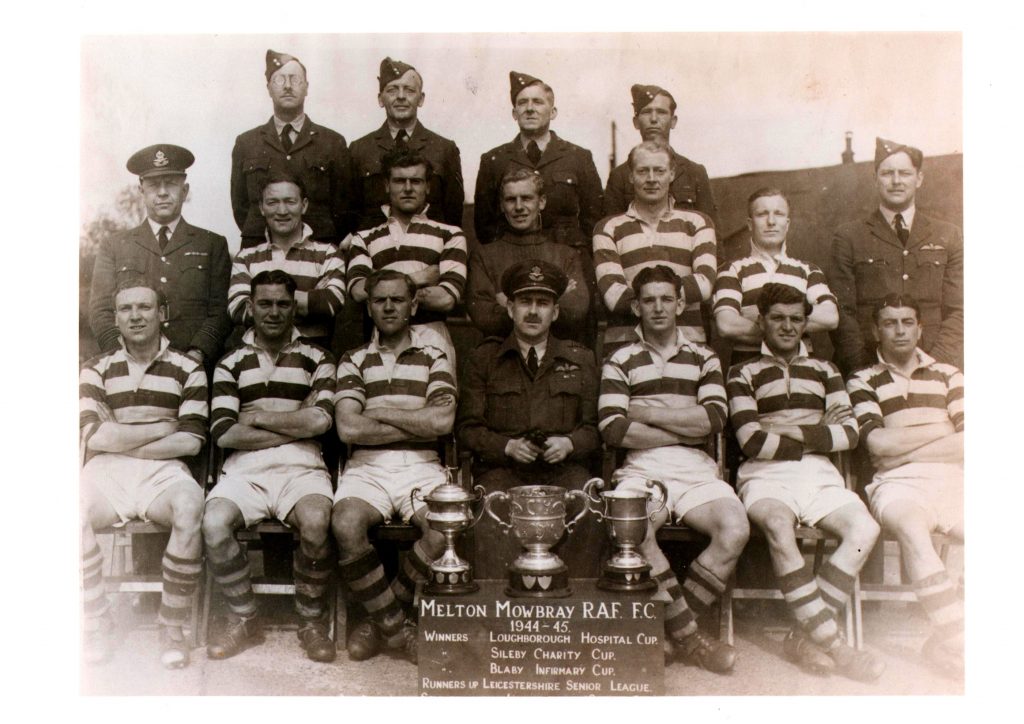
In addition to Jimmy Learmonth, the RAF Melton Mowbray FC team contained several other professional players such as Cpl Andy Bramley who was the team manager and came from Anstey, Bill Maclean was the Leics City trainer, Clem Stevenson played for Huddersfield.
Also serving at Melton was the England player Ivor Broadis, who won his first cap for his Country in 1952. He was a Flight Lieutenant navigator on Wellingtons and Lancaster bombers and had massed over 500 hours without going on a bombing mission. It is not sure if he’s on the team photograph.
Jimmy was an Armourer by trade and most of the time he worked in No 4 Hangar. He remembers one specific day when all the Beaufighters were being put into the hangar for storage. It was quite a common occurrence for the engineers to show people around the aircraft including the cockpit and controls. On this particular day, the engineer was showing the visitors the controls and how the machine guns operated.
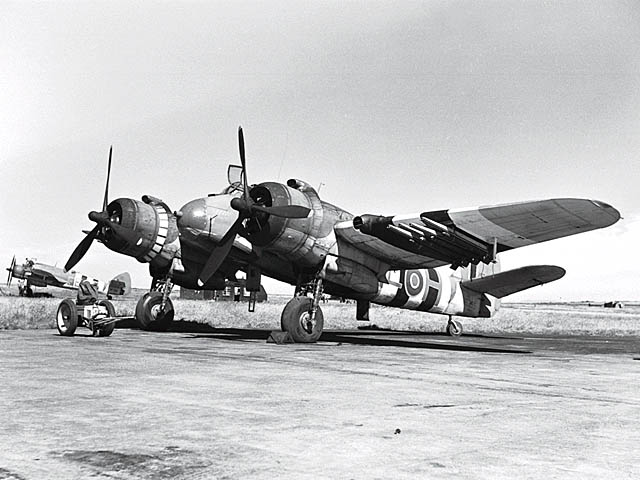
The Beaufighters gun controls was a button which was located on the control column and protected by a flap/cover. All of a sudden, the hangar was filled with the deafening sound of machine gun fire. It turned out to be ‘friendly fire’ and came from the Beaufighter in which Jimmy’s colleague was showing the visitors around. Nobody was actually injured in this incident, except their pride. Normally the aircrafts ammunition was downloaded prior to the aircraft going into the hangar, but for some reason this aircraft was missed.
Another incident that Jimmy remembers began when he was walking his girlfriend (who incidentally is now his wife) home after an evening of dancing. At the bottom of Ankle Hill he was stopped by a couple of Service Policemen (SP’s) who questioned him about being out late at night. It turned out that he didn’t have a late night pass, so the SP’s took his details (Name, Rank and Number) and ordered him to report to the Guardroom immediately. Upon arriving at the Guardroom, Jimmy reported to the Orderly Corporal who told him to report back to the Guardroom at 06.30am the following morning for the Orderly Officers parade. The following morning, Jimmy arrived at the Guardroom only to find that it had been burnt down during the night.
A drunken Scots airman, who was known for being drunk and rowdy had been arrested by the RAF Police (RAFP), who were trying unsuccessfully to lock him up in one of the guardrooms detention cells. The tiny Scotsman who was only 5ft 3” tall managed to escape from the custody of the RAFP and his escorts and evict them out of the guardroom. He then locked him self inside and built a bonfire from all the paperwork, tables and chairs. When the fire was well ablaze, he went outside, started ringing the fire bell and shouted for assistance.
The RAF Fire Service could not attend as they were on airfield duties so the Melton Fire Brigade were called. Subsequently, the guardroom burnt down due to the building being constructed from wood. Upon arrival at the scene, the Scotsman was cooled down with a dowsing from a fireman’s hose and he escaped again, this time down Dalby Road towards town. He was arrested again at the picket post and taken to a more secure cell, this time in the local police station down town. Apparently the local police were not too keen on this as the same Scotsman had been detained in their cells on a previous occasion and had trashed them.
By 6th June 1944 No 304 FTU & No 4 Overseas APU (renamed as No 4 APU on 31st July 1944), both of No 44 Group were operating from Melton. Both of these units amalgamated on the 9th October 1944 and became No 12 Ferry Unit whose role was ferrying aircraft from Melton to overseas units and operated various types of aircraft which included Ansons, Beaufighters, Bostons, Oxfords, Proctors, Stirlings and Wellingtons.

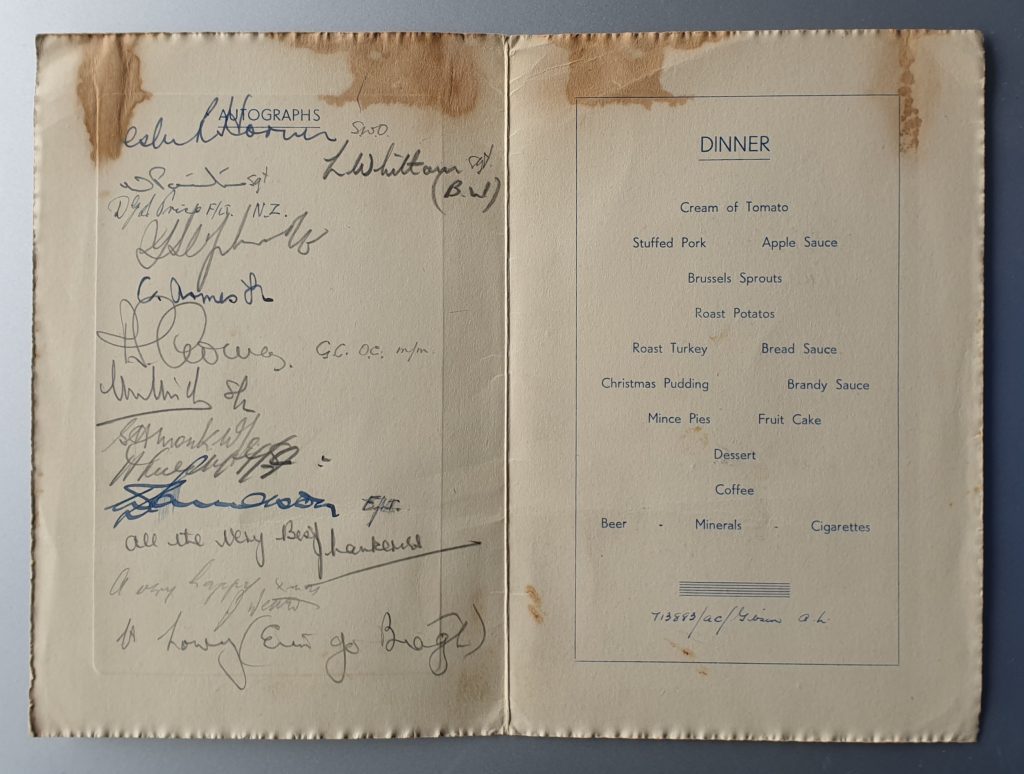
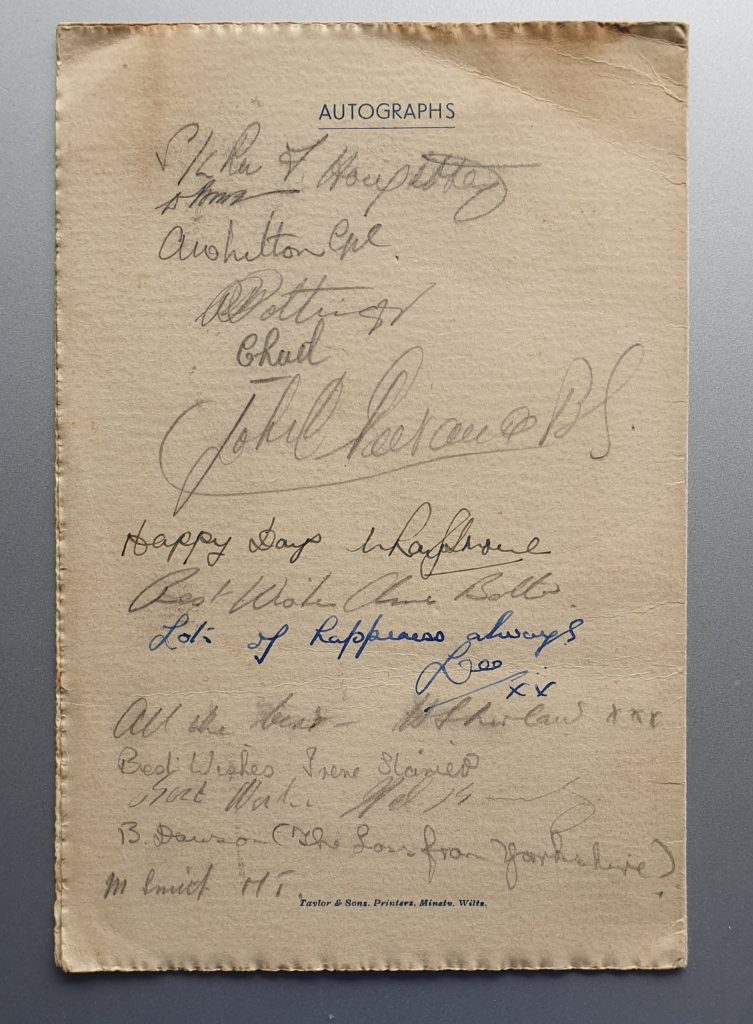
Due to the closure of the APU, the station was able to accept part of No 107 Operational Training Unit whose parent station was Leicester East. The role of this unit was the training of Transport Command crews who were employed in glider towing and troop carrying. No 107 OTU operated Halifaxes and Dakotas along with a fleet of Horsa and Hadrian gliders.
No 1588 Heavy Freight Flight (HFF) was formed at Melton during September 1945 as ‘K’ Flight for service in India. The first of 1588’s Stirling V’s arrived in Bombay/Santa Cruz India on 10 October 1945. K flight was officially disbanded on 20 May 1946, although it actually ceased to exist in July 1946. 1588 was the last unit to operate Stirling’s and No 229 Group sent a signal on 17 July 1946 informing it that all its Stirling’s could be struck off charge and disposed of on site at Santa Cruz Bombay.
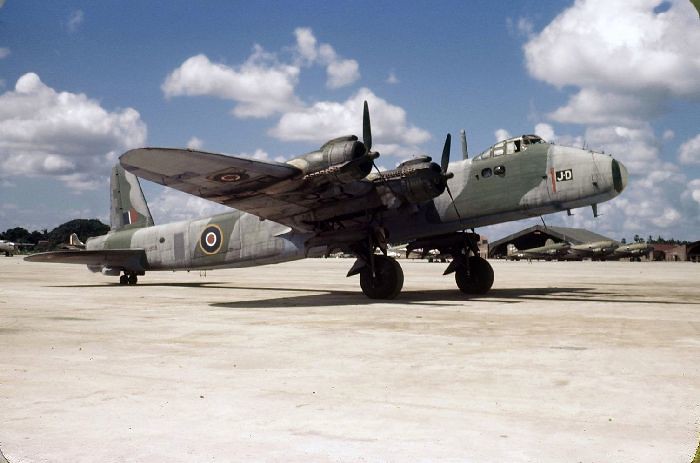
September 28th 1945 saw the formation of No 1589 ‘J’ HFF, again operating Stirling V’s. By 10th October 1945 all of the Stirling V’s belonging to J flight had moved to Cairo West, Egypt and the flight was disbanded on 30th April 1946.
November 1945 saw the departure of No 1333(T) SCU (formally No 107 OTU which was renamed in March earlier that year) and on the 7th No 12 Ferry Unit disbanded.
It was widely reported that there was a mass exodus from the RAF station following the Victory in Europe announcement and all duties at the camp had been suspended, dozens of bicycles were piled up at Melton railway station.
If anyone has any further recollections or photographs etc relating to RAF Melton Mowbray, please do let me know.

